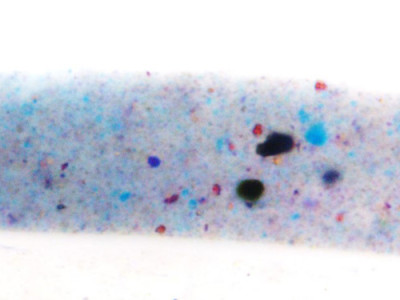Colorants, Pigments, and Extenders
Colorants occur in a wide range of materials; however, characterization of these particles can be difficult due to their small size and the fact that they are generally mixed or embedded into a matrix at a low concentration. Microtrace has conducted years of research into developing some of the most advanced methods for systematically characterizing and identifying colorants. Whether characterizing properties of a new product, identifying colorants within a finished product, or attributing the presence of such particles located in trace evidence to a particular source, Microtrace has the necessary experience, reference collections, and analytical techniques to provide the highest level analysis.
Pigments
Commercial and artistic, organic and inorganic, novel and historical, Microtrace maintains an extensive pigment reference collection. Our scientists have conducted peer reviewed research documenting novel methods for visualizing, classifying, and identifying these particles in automotive and architectural paints, pigmented inks, and cosmetics using Raman spectroscopy and surface enhanced resonance spectroscopy (SERS). Highly engineered effect pigments have a variety of interesting properties that can be prepared by ion beam cross section polishing and studied by field emission scanning electron microscopy (see image gallery above for a cross sectioned coated pigment).
Dyes and Lakes
Food coloring, fiber dyes, and inks represent some of the major commercial uses of dyes. Whether the analysis involves separation and comparison of possible questioned and known dyes or dye identification, Microtrace has developed in house expertise and techniques to solve the task. We have conducted research ranging from comprehensive dye identification to the identification of dyes in specialty products such as bank security dye packs.
Fillers and Extenders
Inorganic fillers and extenders such as kaolinite, talc, silica, diatomaceous earth, and calcium carbonate (among many others) can be identified in finished products or systematically characterized to identify particle size, morphology, polymorph, and bulk or trace element composition. While this is particularly useful for forensic examinations of paint and polymers, this information can also be of assistance when attempting to understand the properties of a new raw material or comparing a new source to an existing supplier.
Related Standardized Methods: ASTM E1610, E2808, E2809, E2937
How May We Help You?
Contact usto discuss your project in more detail.








